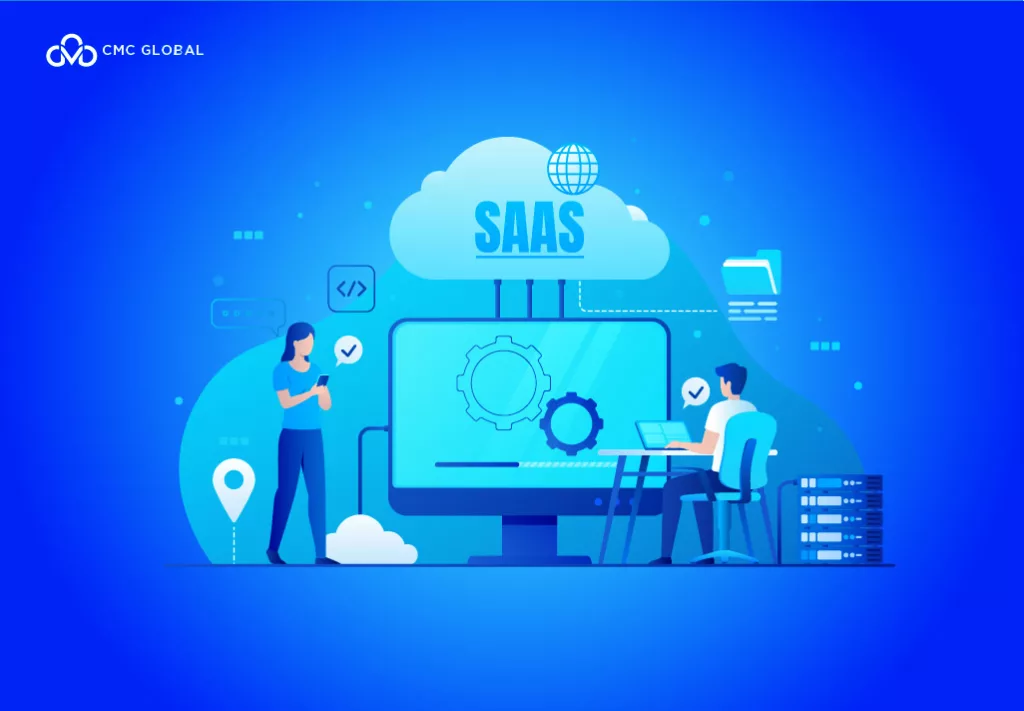Services like custom software development can be found at any software company around the world. It starts as a simple idea of a feature or a system that can do the work for you. The scope of work is varied: from Custom Web Application Development, Custom Mobile App Development, and Custom Database Development to User Experience and Design, and you – the business needs someone who can make this idea into reality. This is when you need to truly understand everything about customizing your own software product and anything that goes with it.
Check out this article about the custom software development of CMC Global to see if you truly understand this service!
What is Custom software development?

People think about custom software development when their business has a specific software need that can not be solved with off-the-shelf software. Because custom software development is the result of a unique technology solution, which is more expensive and detailed than an out-of-the-box software solution. The reason for this is that custom software development is uniquely designed for specific users and business requirements, not packaged for resale.
Compare Custom software vs. off-the-shelf software.

The traditional product, aka off-the-shelf software, consists of a packaged application that a large number of users with varying needs can use. For example, the Microsoft Word application is built for the mass public as it can serve the diverse needs of its users. This also means it does not cater to a specific group/ need as custom software would.
On the contrary, customized software products are designed for a single entity to serve its purpose only. For example, CMC Global developed a customized application for transportation that helps to carry cargo. The products would be used only by that company and the department for which it was designed. The final products include a website for shippers (booking and management), a website for carriers (dispatchers, owner-drivers), a mobile application for carriers, and a website for the admin to manage all information of the system. At the end of the day, the software is designed with the company’s infrastructure, branding guidelines, and implementation needs so that it works only for that organization.
The pros of custom software development
The biggest pros of custom software lie in its name: it is custom for the specific need only, which usually leads to an increased level of productivity when applied to reality.
At first, paying for a designed software application to serve an internal need seems to cost much more and take longer to launch than off-the-shelf options. However, in the long term, using customized systems can be a smarter and more reasonable solution for businesses since their work can be optimized, saving time and effort for the employees and helping them focus on other segments of the job.
The cons of custom software development
The cost may discourage you.
The biggest problem is the cost. Depending on the type of product, an off-the-shelf software application normally ranges from a few dollars to a couple of thousand dollars. But a designed application can cost much more than that. Because it has to be structured based on how the users want it to be and have features to serve its own requirements, the designing of customized software requires significant resources. Therefore, some custom applications can reach five figures.
Or you can have your requirement checked by our business experts and get the proposal that best suit your need, budget, and vision via:
The risks that go with it
The risks associated with custom software development are something to bear in mind, too. Building a custom solution requires the business to have an in-depth knowledge of their company, process, and requirement so that the communication process goes smoothly and clearly.
One thing to keep in mind is that it is fairly common for customers to discover new needs during the development process. This happens every time, and it can result in added costs and development time. However, frequent changes may negatively affect your project: the final result can be insufficient or significantly different from what they originally intended.
The partner needs to be thought of twice.
Picking the right software development company, it’s not easy. Many searches for companies that bid to work, some choose by references, and some choose based on previous projects and price competition. What we can advise you is to choose someone who has been in this industry for a long time, with a good reputation, a large IT Talent pool, and good reviews from previous customers. Don’t just simply pick the cheapest bid, but instead, choose the partner that will best meet your needs.
Best practices for developing custom software

What are your current process and future needs?
To build or custom anything, the first step is to know where you are and where to aim at. Therefore, it’s critical to sit back and define your current process, your expectations as well as key metrics to measure success and results. And thus, make sure you know the following:
- The current process situation: Don’t make any assumptions, but ask subject-matter experts who handle the work daily so that you have the most practical insights about the process as well as their requirements. This is also the chance to get why changes need to be made.
- The desired state: After thoroughly understanding the current situation, sketch the desired workflows and other processes that the software is meant to support, and get it confirmed by your organization’s CIOs before making any finance-related decision.
Choose the right people.
When you decide that yes, I need my system to be customized, two kinds of people can do that for you:
- Your internal IT team: They are the ones that you hire or contract specifically for the job. Getting them
- Software development vendors and companies: they handle everything for you with their experts in BA and IT Talents. To save money, you can turn to service providers offshore in countries such as Vietnam, India, or Ukraine for better prices in comparison to local peers. Sound too good to be true? Your team can face huge drawbacks if you don’t know how to manage a hired IT team properly, such as no obligations, no clear work metrics/ KPIs, miscommunicated tech personnel, and so on.
Choosing to outsource your IT team can save you time, effort, and money but, at the same time, can cost you a hefty if you don’t know how to do this right.
Read our CIOs playbook: Start managing software development teams like a pro
Plan your project with a realistic mindset.
You pay for the service, and you have all the right to require its function, features, productivity, and so on. However, a plan must be realistic in terms of budget, time, and scope. With a team including 3 to 5 developers, one BA, subject-matter experts, and a team leader, you can’t create a complex workflow and shipping system in a week, for example.
So, know your resource and plan for milestones to keep your work on track. When you have your project divided into smaller ones, the future vision is clearer not only for you but for your teammate and your hired IT team also. By that, they can get the work done at a certain time and budget amount, have it tested, and make any changes at planned timelines?
Everything must be tested.
Before launching or implementing anything, testing is a big must and should be done on two levels:
- Developers and IT professionals conduct technical testing to ensure the foundational elements work properly.
- Clients or business beta users conduct user testing. It tests that the software works as expected and desired.
Documentation is King
Documentation ensures a new CIO/ project manager fully understands how the project will turn out to be and to get it done. It is important for all stages of development and implementation. What you should have are:
- A test plan and its checklist so you know your software is fully vested.
- A scope statement to follow so that you don’t end up solving too many problems with the software.
- An implementation plan that fully defines who uses the software, how, and when.
- A training plan and detailed user documentation to ensure new personnel isn’t left frustrated and with questions in case of turnover.
Keys to effective custom software development

Be sure you want to build or buy
The first question to ask is, should you outsource? And if you do, how much should be outsourced? Software solution finder and researcher Capterra reports that 75% of business and IT executives anticipate their software projects to fail. So, what’s good in the building anyway?
CMC Global’s approach to a build-vs-buy dilemma is to ask if there is already a packaged software solution delivering greater than 80% of the functions needed to:
- Support or automate unique processes and transactions of the business
- Meet unique privacy or security requirements
- Integrate with legacy applications and data
- Replace or help consolidate existing solutions at a lower cost or to achieve greater productivity
- Enable new opportunities or enhance an organization’s competitive advantage.
- Grow and adapt to changing requirements of the business or market.
Requirements must be “good enough”
To have a shared vision for the software project, businesses must define a clear outcome, requirements, and milestones for outsourcing service providers so that they stick to your plan while addressing compliance and staying on schedule and within budget. This is the route you take to deliver a high, fast ROI. At the end of the day, your requirement should be:
- Clear (unambiguous and not confusing)
- Correct (technically and legally possible)
- Complete (expresses a whole idea or statement)
- Consistent (not in conflict with other requirements)
- Feasible (can be accomplished within cost and schedule)
- Verifiable (can be determined that the application meets the requirement)
- Traceable (uniquely identified and tracked)
- Modular (can be changed without excessive impact)
- Design independent (does not impose specific solutions on design).
Methodologies, technologies, and practices
After you have defined the requirements (and trust us, they will likely change more than once), the next step to take is applying mature, modern development methodologies and practices.
Development methodologies to consider:
- Agile: Agile is adopting a leadership mindset that combines teamwork, self-organization, and accountability. This approach focuses on continuously aligning the development process with customer needs and market trends, despite the fact that those needs and trends can change late in the development process.
- DevOps: DevOps aims at bringing software development teams and information technology operatives together. It is a methodology that promotes collaboration from the initial phase right through to product release between two teams that historically worked in their own separate silos. It combines software development (Dev) with operations (Ops) to enable communication between the teams so that they can build, test, and release software quickly, with greater efficiency and speed.
Can you differentiate Waterfall, Agile, and DevOps? Read this article about the most common development model to find your answer: Development model explained: Waterfall vs Agile vs Iterative and more
Technologies and practices to consider:
- Open source: Open source is software source code open to the public. This means development companies can use them to build their own custom software development WordPress and Linux are two noticeable examples.
- Artificial Intelligence (AI): AI enables software to take over the process of decision-making by learning from time to time. What is its role in the development process? AI technologies such as machine learning and modeling can be acquired and incorporated into applications through application programming interfaces (API) and services from the cloud.
- Cloud: Cloud-based development introduces the advantages of cloud computing to software development. Its cloud hosts development environments that support coding, design, integration, testing, and so on.
- Blockchain: Blockchain is a secure technology that eliminates the cost and vulnerability introduced by banks, regulatory bodies, and other intermediaries. Developers can use blockchain ledgers and open source to build new types of secure transactional and financial applications.
- Low code: This is a development practice reducing the need for coding and enables non-coders/citizen developers to build or join in the software building process quickly and at a lower cost.
Custom software development lets businesses take advantage of technology to solve specific problems. And thus, understanding how to determine whether custom software development is the right choice and how to implement them can support great growth and success.




